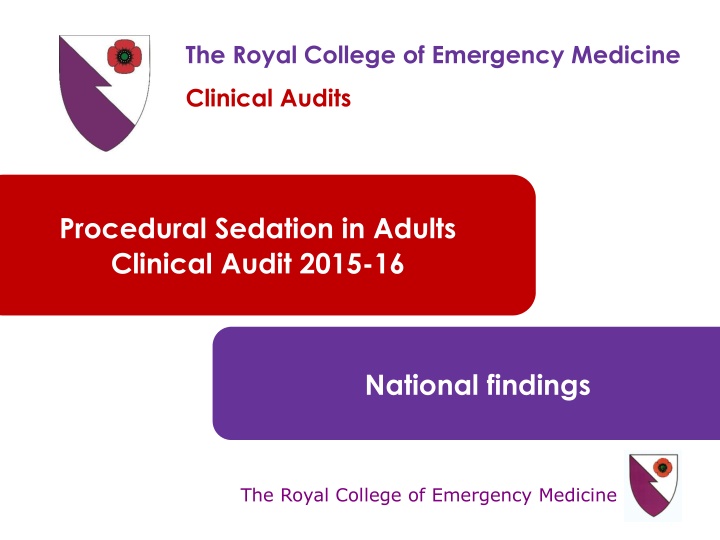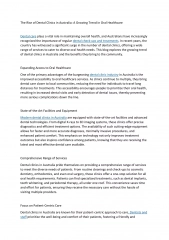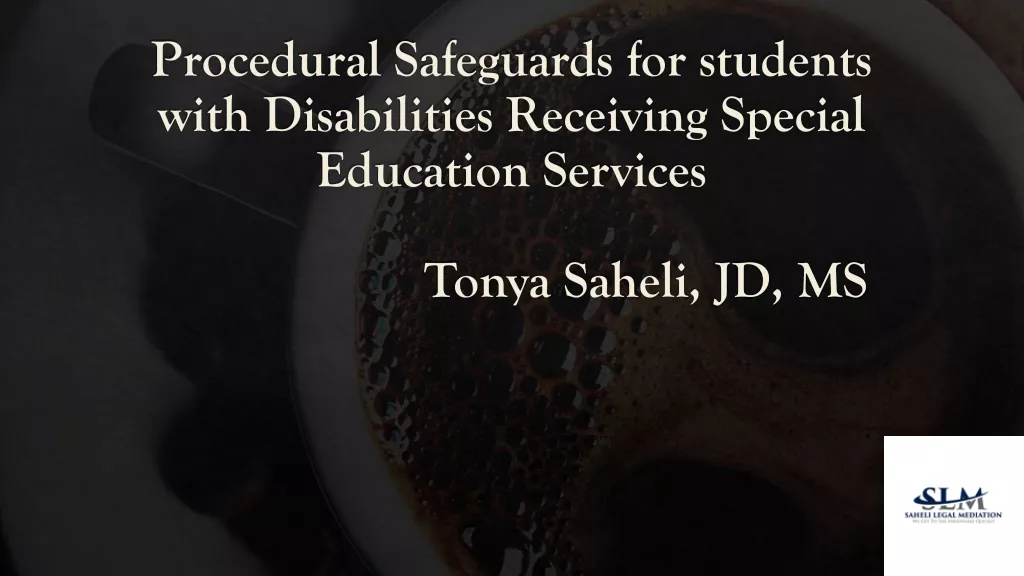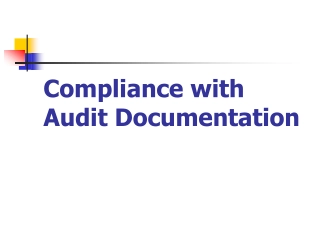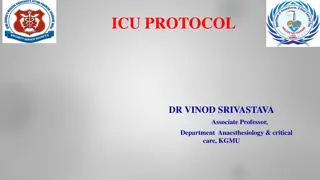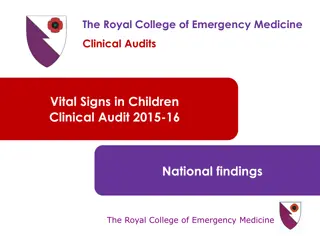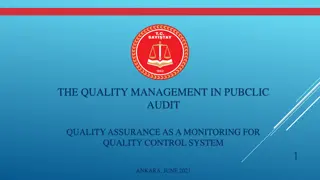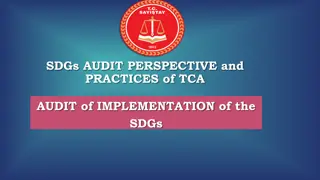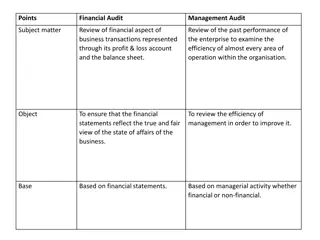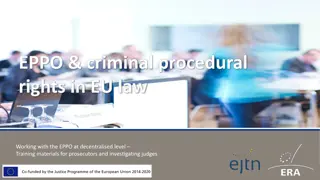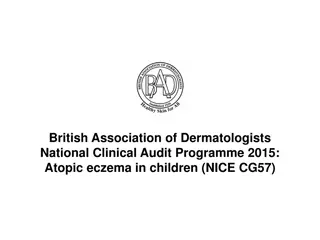Procedural Sedation in Adults Clinical Audit 2015-16 National findings
A clinical audit conducted by The Royal College of Emergency Medicine in 2015-16 focused on procedural sedation in adults, aiming to assess the performance of emergency departments against clinical standards. The audit objectives included evaluating pre-procedural assessments, consent procedures, sedation environment requirements, monitoring protocols during sedation, and discharge criteria. National findings and standards for procedural sedation are presented, highlighting compliance levels across different aspects of care provided in emergency departments.
Download Presentation

Please find below an Image/Link to download the presentation.
The content on the website is provided AS IS for your information and personal use only. It may not be sold, licensed, or shared on other websites without obtaining consent from the author.If you encounter any issues during the download, it is possible that the publisher has removed the file from their server.
You are allowed to download the files provided on this website for personal or commercial use, subject to the condition that they are used lawfully. All files are the property of their respective owners.
The content on the website is provided AS IS for your information and personal use only. It may not be sold, licensed, or shared on other websites without obtaining consent from the author.
E N D
Presentation Transcript
The Royal College of Emergency Medicine Clinical Audits Procedural Sedation in Adults Clinical Audit 2015-16 National findings The Royal College of Emergency Medicine
Contents This shows how EDs are performing against the audit standards. For further information, please see the national report.
Audit objective Identify current performance in EDs against clinical standards and display the results in order to facilitate quality improvement.
Standards (part 1) Standard Standard type 1. Patients undergoing procedural sedation in the ED should have documented evidence of pre-procedural assessment, including all: Fundamental a. ASA grading b. Prediction of difficulty in airway management c. Pre-procedural fasting status 2. There should be documented evidence of the patient s informed consent unless lack of mental capacity has been recorded Developmental 3. Procedural sedation should be undertaken in a resuscitation room or one with dedicated resuscitation facilities. Fundamental 4. Procedural sedation requires the presence of all of the below a. A doctor as sedationist Fundamental b. A second doctor, ENP or ANP as procedurist c. A nurse
Standards (part 2) Standard Standard type 5. Monitoring during procedural sedation must be documented to have included all of the below Fundamental a. Non-invasive blood pressure b. Pulse oximetry c. Capnography d. ECG 6. Oxygen should be given from the start of sedative administration until the patient is ready for discharge from the recovery area. Developmental 7. Following procedural sedation, patients should only be discharged after documented formal assessment of suitability, including all of the below (a) Fundamental (b) Fundamental a. Return to baseline level of consciousness b. Vital signs within normal limits for the patient c. Absence of respiratory compromise d. Absence of significant pain and discomfort (c) Fundamental (d) Fundamental (e) Developmental e. Written advice on discharge for all patients
Executive summary This graph shows how EDs performed on all standards for this audit. Higher scores (e.g. 100%) indicate higher compliance with the standards and better performance. Standards: Fundamental Developmental
National results (part 1) National Results (8845 cases) Standard RCEM Lower quartile Upper quartile Median STANDARD 1: Patients undergoing procedural sedation in the ED should have documented evidence of pre-procedural assessment, including a) ASA grading, b) prediction of difficulty in airway management and c) pre- procedural fasting status. 100% 0% 8% 39% STANDARD 2: There should be documented evidence of the patient s informed consent unless lack of mental capacity has been recorded. 24% 52% 74% 100% STANDARD 3: Procedural sedation should be undertaken in a resuscitation room or one with dedicated resuscitation facilities. 71% 91% 98% 100%
National results (part 2) National Results (8845 cases) Standard RCEM Lower quartile Upper quartile Median STANDARD 4: Procedural sedation requires the presence of all of the below a) a doctor as sedationist, b) a second doctor, ENP or ANP as procedurist, c) a nurse. 16% 42% 67% 100% STANDARD 5: Monitoring during procedural sedation must be documented to have included all of the below a) non-invasive blood pressure b) Pulse oximetry, c) Capnography, d) ECG. 100% 0% 8% 39% STANDARD 6: Oxygen should be given from the start of sedative administration until the patient is ready for discharge from the recovery area. 24% 52% 74% 100%
National results (part 3) National Results (8845 cases) Standard RCEM Lower quartile Upper quartile Median STANDARD 7: Following procedural sedation, patients should only be discharged after documented formal assessment of suitability, including all of the below: 100% 0% 3% 17% a. Return to baseline level of consciousness 100% 31% 56% 81% b. Vital signs within normal limits for the patient 100% 34% 59% 84% c. Absence of respiratory compromise 100% 8% 39% 71% d. Absence of significant pain and discomfort 100% 7% 25% 55% e. Written advice on discharge for all patients 100% 3% 15% 32%
Casemix How do patients attending EDs compare nationally? This section helps you understand more about the case mix and demographics of the patients.
Level of sedation intended and achieved Sample: all patients This pie chart shows that most of the time, level of sedation information is not recorded. The intended level of sedation should be decided and recorded before the procedure. Where sedation levels are routinely deeper than intended, EDs should reflect on the reasons and consider patient safety implications.
Level of sedation intended and achieved Achieved Conscious Minimal Dissociative Deep Not recorded 22.75% 0.76% 1.72% 0.03% 7.16% Conscious 0.28% 2.91% 0.06% 0.00% 0.63% Minimal Intended 0.05% 0.01% 0.07% 1.83% 0.21% Dissociative 0.24% 0.01% 4.44% 0.02% 1.24% Deep 5.63% 1.87% 3.28% 0.52% 44.28% Not recorded
Audit results How did EDs perform against the standards? This section helps you understand more about how EDs performed nationally.
Pre-procedure assessment STANDARD 1: Patients undergoing procedural sedation in the ED should have documented evidence of pre- procedural assessment, including: a) ASA grading; b) Prediction of difficulty in airway management; c) Pre- procedural fasting status Sample: all patients This information is important in predicting complications. The standard was met in less than a quarter of the instances audited. This is a clear area for improvement.
Informed consent STANDARD 2: There should be documented evidence of the patient s informed consent unless lack of mental capacity has been recorded Sample: all patients While in some circumstances full written consent is unfeasible, documented verbal consent with appropriate explanation of risk should be undertaken as a minimum standard. It is not acceptable from a patient or clinical risk perspective that nearly half of patients did not have consent recorded.
Sedation undertaken in resus room STANDARD 3: Procedural sedation should be undertaken in a resuscitation room or one with dedicated resuscitation facilities Sample: all patients The standard was met in fewer cases where propofol was the sedating agent, which is of concern.
Staff present during procedure STANDARD 4: Procedural sedation requires the presence of: a) a doctor as sedationist; b) a second doctor, ENP or ANP as procedurist; c) a nurse Sample: all patients There is a clear duty to the patient and for clinical governance to record who is in the room at the time the patient is sedated. (all = doctor, second doctor/ENP/ANP procedurist and nurse)
Monitoring during procedure STANDARD 5: Monitoring during procedural sedation must be documented to have included all of: a) Non-invasive blood pressure; b) Pulse oximetry; c) Capnography; d) ECG. Sample: all patients Capnography (CO2 monitoring) is a relatively recent addition to standards for sedation practice, however it is now accepted as fundamental.
When was oxygen given? STANDARD 6: Oxygen should be given from the start of sedative administration until the patient is ready for discharge from the recovery area. Sample: all patients This shows that most of the time, if patients are breathing supplemental oxygen, this is normally commenced from the start of sedation.
Discharge assessment STANDARD 7: Following procedural sedation, patients should only be discharged after documented formal assessment of suitability, including all of: a) Return to baseline level of consciousness; b) Vital signs within normal limits for the patient; c) Absence of respiratory compromise; d) Absence of significant pain and discomfort; e) Written advice on discharge for all patients. Sample: Q19=yes (n=4616) At a minimum, discharging the patient with a leaflet that explains the treatment and any safety net (i.e. what to watch for ) is good practice, as patients may not retain discharge advice, particularly if still partly sedated.
Recommendations 1. EDs must investigate and address the reasons for sedations performed outside of the resuscitation room or one with dedicated resuscitation facilities. Checklist and guidance use: Hospitals must have protocols that ensure that staff using sedation are qualified to do so, and perform sedation only in safe situations with adequate staffing. A pro-forma should be used for procedural sedation and analgesia (PSA) as a checklist and as a record of the procedure. A safe sedation pro-forma has been developed by RCEM and departments must implement this (or a local version) prior to re-audit Ensure that the recommendations for ED sedation described in Safe Sedation of Adults in the Emergency Department (RCoA and RCEM, Nov 2012) are met (see appendix 5). Written discharge advice should be developed, if one does not already exist, and implemented. Examples of discharge advice are available here. 2.
Recommendations 3. ED clinicians should ensure adequate documentation of pre- procedural assessment and of patients informed consent. 4. ED clinicians should ensure adequate documentation of monitoring during procedural sedation and that an accurate record of the event is completed. 5. ED clinicians should ensure adequate documentation of formal assessment of suitability for discharge. 6. Hospitals must support adverse event recording using the World SIVA reporting tool .
Next steps Read the full report Action planning Rapid cycle quality improvement Contact other EDs for tips & solutions
